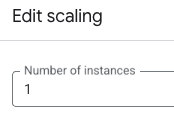Halaman ini menunjukkan cara menskalakan pool pekerja secara manual.
Ringkasan
Penskalaan manual memungkinkan Anda menetapkan jumlah instance tertentu tanpa memerlukan deployment ulang. Hal ini memberi Anda opsi untuk menulis logika penskalaan sendiri menggunakan sistem eksternal. Lihat Kafka Autoscaler untuk contohnya.
Pertimbangan penagihan saat menggunakan penskalaan manual
Saat Anda menggunakan penskalaan manual, semua instance yang Anda minta akan ditagih sebagai instance aktif, meskipun instance tersebut sedang tidak digunakan. Untuk mengetahui detail penagihan selengkapnya, lihat halaman harga.
Peran yang diperlukan
Untuk mendapatkan izin yang diperlukan untuk men-deploy kumpulan pekerja Cloud Run, minta administrator untuk memberi Anda peran IAM berikut:
-
Developer Cloud Run (
roles/run.developer) di layanan Cloud Run -
Service Account User (
roles/iam.serviceAccountUser) pada identitas layanan -
Pembaca Artifact Registry (
roles/artifactregistry.reader) di repositori Artifact Registry dari image container yang di-deploy (jika berlaku)
Untuk mengetahui daftar peran dan izin IAM yang terkait dengan Cloud Run, lihat Peran IAM Cloud Run dan Izin IAM Cloud Run. Jika kumpulan worker Cloud Run Anda berinteraksi dengan APIGoogle Cloud , seperti Library Klien Cloud, lihat panduan konfigurasi identitas layanan. Untuk mengetahui informasi selengkapnya tentang cara memberikan peran, lihat izin deployment dan mengelola akses.
Mengonfigurasi penskalaan
Mengubah mode penskalaan atau mengubah jumlah instance manual tidak akan membuat revisi baru.
Untuk mengonfigurasi mode penskalaan, gunakan konsol Google Cloud , Google Cloud CLI, YAML, atau Terraform:
Konsol
Di konsol Google Cloud , buka Cloud Run:
Jika Anda mengonfigurasi kumpulan pekerja baru, pilih Worker pools dari menu, lalu klik Deploy container. Jika Anda mengonfigurasi kumpulan pekerja yang ada, klik kumpulan pekerja untuk menampilkan panel detailnya, lalu klik ikon pena di samping Penskalaan di kanan atas panel detail.
Temukan formulir Penskalaan (untuk kumpulan pekerja baru) atau formulir Edit penskalaan untuk kumpulan pekerja yang ada.

Di kolom berlabel Number of instances, tentukan jumlah instance container untuk layanan.
Selesaikan spesifikasi.
Klik Buat untuk kumpulan pekerja baru atau Simpan untuk kumpulan pekerja yang ada.
gcloud
Untuk menentukan penskalaan bagi kumpulan pekerja baru, gunakan perintah deploy:
gcloud beta run worker-pools deploy WORKER_POOL \ --scaling=INSTANCE_COUNT \ --image IMAGE_URL
Ganti kode berikut:
- WORKER_POOL: nama kumpulan pekerja Anda.
- INSTANCE_COUNT: jumlah instance untuk worker pool.
Tindakan ini akan menyetel kumpulan pekerja ke penskalaan manual. Tentukan nilai
0untuk menonaktifkan worker pool. - IMAGE_URL: referensi ke image container yang
berisi worker pool, seperti
us-docker.pkg.dev/cloudrun/container/worker-pool:latest.
Tentukan penskalaan untuk worker pool yang ada menggunakan perintah update berikut:
gcloud beta run worker-pools update WORKER_POOL \ --scaling=INSTANCE_COUNT
YAML
Jika Anda membuat kumpulan pekerja baru, lewati langkah ini. Jika Anda memperbarui kumpulan pekerja yang ada, download konfigurasi YAML-nya:
gcloud beta run worker-pools describe WORKER_POOL --format export > workerpool.yaml
Contoh berikut berisi konfigurasi YAML:
apiVersion: run.googleapis.com/v1 kind: WorkerPool metadata: name: WORKER_POOL annotations: run.googleapis.com/launch-stage: BETA run.googleapis.com/manualInstanceCount: `INSTANCE_COUNT`
Ganti kode berikut:
- WORKER_POOL: nama kumpulan pekerja Cloud Run Anda.
- INSTANCE_COUNT: jumlah instance yang Anda skalakan secara manual
untuk worker pool. Tentukan nilai
0untuk menonaktifkan worker pool.
Buat atau update kumpulan pekerja menggunakan perintah berikut:
gcloud beta run worker-pools replace workerpool.yaml
Terraform
Untuk mempelajari cara menerapkan atau menghapus konfigurasi Terraform, lihat Perintah dasar Terraform.
resource "google_cloud_run_v2_worker_pool" "default" {
name = "WORKER_POOL"
location = "REGION"
launch_stage = "BETA"
template {
containers {
image = "IMAGE_URL"
}
}
scaling {
scaling_mode = "MANUAL"
manual_instance_count = "INSTANCE_COUNT"
}
}
Ganti kode berikut:
- WORKER_POOL: nama pool pekerja.
- REGION: Google Cloud region—misalnya,
europe-west1. - IMAGE_URL: referensi ke image container yang
berisi worker pool, seperti
us-docker.pkg.dev/cloudrun/container/worker-pool:latest. - INSTANCE_COUNT: jumlah instance untuk worker pool.
Tindakan ini akan menyetel kumpulan pekerja ke penskalaan manual. Tentukan nilai
0untuk menonaktifkan worker pool.
Melihat konfigurasi penskalaan untuk kumpulan pekerja
Di konsol Google Cloud , buka Cloud Run:
Klik Worker pools untuk menampilkan daftar worker pool yang di-deploy.
Klik kumpulan pekerja yang ingin Anda periksa untuk menampilkan panel detailnya.
Setelan penskalaan saat ini ditampilkan di atas daftar revisi kumpulan pekerja: Penskalaan: Manual (Instance: ).
Menonaktifkan kumpulan pekerja
Untuk menonaktifkan kumpulan pekerja, gunakan perintah berikut untuk menyetel penskalaan ke nol:
gcloud beta run worker-pools update WORKER_POOL --scaling=0
Ganti WORKER_POOL dengan nama kumpulan pekerja Anda.

